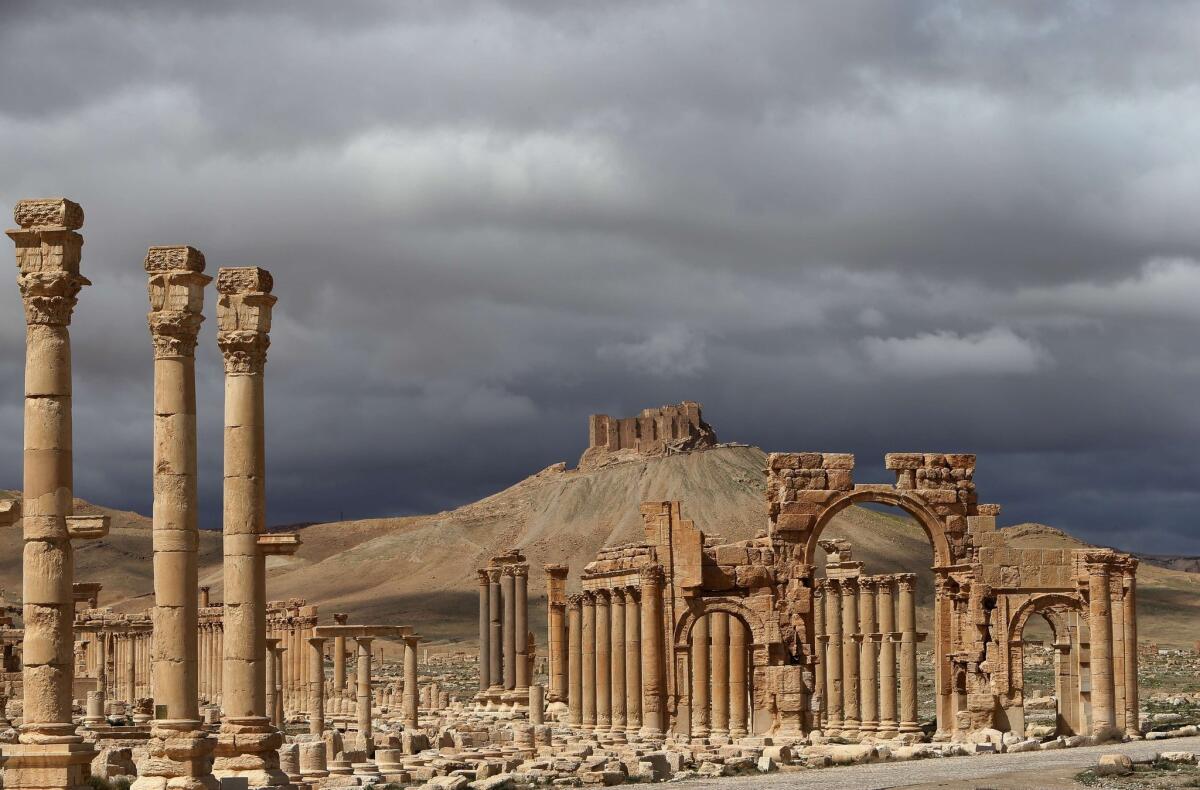Roundup: USC students boycott graduation; Fox station censors Picasso

ISIS advances have threatened Syria’s ancient oasis city of Palmyra. The UNESCO World Heritage Site, seen here in 2014, married Greco-Roman and Persian influences.
- Share via
The announced withdrawal of an entire MFA class from USC’s Roski School of Art and Design continues to make news. Historic ruins are threatened in Syria. A Picasso inspires talk of inequity and censorship. And Renzo Piano’s Academy Museum moves forward. Plus: Yoko Ono’s career reconsidered, women artists in their 80s and 90s, and words as drum beats. Roundup is groovy today:
— Second-year USC MFA students boycotted their graduation ceremony in support of the seven first-years who announced their withdrawal over curriculum and other changes. (My own report on the withdrawl can be found here.)
— The ISIS advance is now threatening ancient ruins at Palmyra in Syria. For now, the militants are being held back beyond the borders of the UNESCO World Heritage Site.
— From the Annals of Overly P.C. Ideas: A group of Columbia students say Greek mythology needs a trigger warning — an alert about material that could be distressing.
— Speaking of P.C.: Portions of a painting by Picasso were blurred out by a Fox News affiliate because they contained nudity (of the Cubist variety). Slate imagines how other works of iconic art would look like with the naughty bits all pixelated out. Gold star for the inclusion of an abstract canvas by Mark Rothko.
— Bonus: How that same $179 million Picasso explains global inequity. Plus, the countless other things you can buy with that chunk of change. Who needs Picasso when you can pick up an F-35?
— The Whitney Museum quoted my colleague Christopher Knight in a wall text — and it was totally out of context. The most incredible part: They are refusing to change it in any meaningful way. Sensationalism: 1. Thoughtful writing: 0.
— Renzo Piano’s Academy Museum has cleared another hurdle: The City Planning Commission has given the environmental review a thumbs up.
— Speaking of museums, Mostafa Heddaya at Artinfo has analyzed the price of New York museum admission over time — and, as you might expect, it’s gotten more expensive, even when adjusted for inflation.
— Reconsidering the work of Yoko Ono.
— “What I see less and less often, in the art realm and every other realm invaded by digital devices and their corporate puppeteers, is people savoring their experience.” -- Critic Kenneth Baker, who is retiring from the San Francisco Chronicle, reflects on three decades in the art and media business.
— And because this is a good time to bring up the looming singularity: A pair of Rutgers computer scientists have created an algorithm that can look at a painting and detect a work’s genre and style.
— Parsing Britain’s Turner Prize nominees: Nominated projects have gotten more socially conscious, and even include an activist architectural collective in the mix.
— The New York Times has a photographic portfolio by Stefan Ruiz of women artists in their 80s and 90s.
— Looking at Chris Burden’s art as an “outsider architecture practice.”
— Last days of the Okura: An iconic Modernist hotel in Tokyo is being torn down to make way for the 2020 Olympic Games. Travel + Leisure has a worthwhile photo essay of its incredible design elements.
— How ghettoes were legislated into existence — a must-listen piece on NPR on some of the insidious forces that have shaped our cities, among them: the federal government. (With some interesting anecdotes about racial covenants in Culver City in the 1940s, at about minute 17:00.)
— Sort of related: Ben Davis has a terrific Q&A with Baltimore artist Paul Rucker about the ways in which he deals with questions of power and race in his work.
— Google’s self-driving car wins the London Design Museum’s Design of the Year Contest. Also on the list: Chilean architect Alejandro Aravena’s Innovation Center in Santiago (which I featured here in March). More proof that Chilean architects are gaining in global influence.
— “What we have, uniquely in America, is a political class, and an entire political party, devoted to the idea that any money spent on public goods is money misplaced, not because the state goods might not be good but because they would distract us from the larger principle that no ultimate good can be found in the state.” In the wake of the Philadelphia train derailment, Adam Gopnik has a terrific essay in the New Yorker on why American infrastructure is a hot mess.
— And last but not least: A website that translates words into drum beats. (Hyperallergic)
Find me on Twitter @cmonstah.
More to Read
The biggest entertainment stories
Get our big stories about Hollywood, film, television, music, arts, culture and more right in your inbox as soon as they publish.
You may occasionally receive promotional content from the Los Angeles Times.











